fuel consumption SKODA YETI 2010 1.G / 5L Owner's Manual
[x] Cancel search | Manufacturer: SKODA, Model Year: 2010, Model line: YETI, Model: SKODA YETI 2010 1.G / 5LPages: 271, PDF Size: 14.71 MB
Page 5 of 271
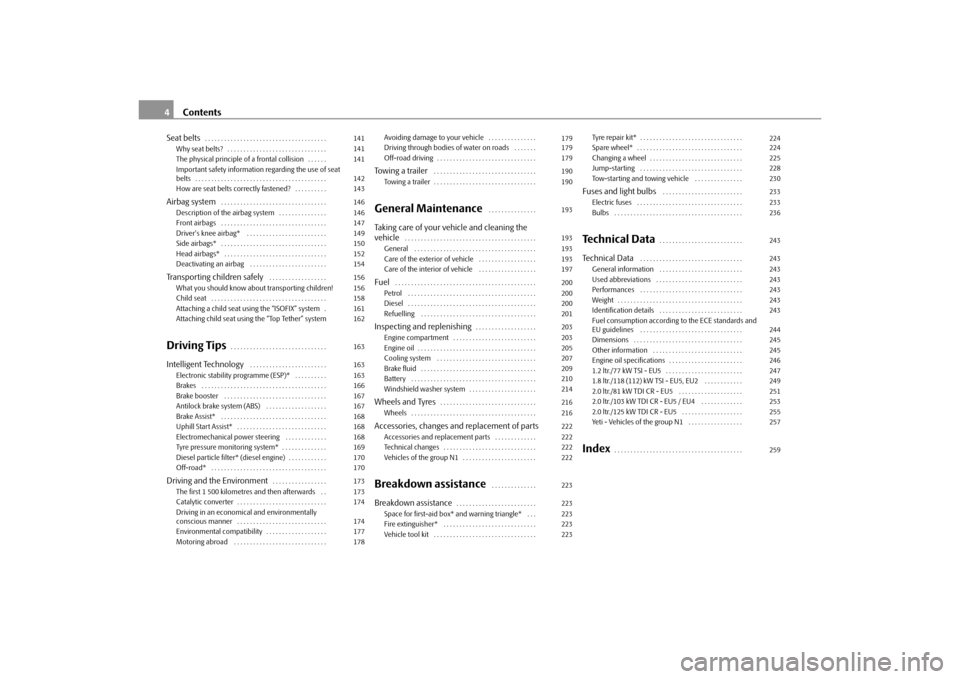
Contents
4
Seat belts
. . . . . . . . . . . . . . . . . . . . . . . . . . . . . . . . . . . . . .
Why seat belts? . . . . . . . . . . . . . . . . . . . . . . . . . . . . . . .
The physical principle of a frontal collision . . . . . .
Important safety information regarding the use of seat
belts . . . . . . . . . . . . . . . . . . . . . . . . . . . . . . . . . . . . . . . . .
How are seat belts correctly fastened? . . . . . . . . . .
Airbag system
. . . . . . . . . . . . . . . . . . . . . . . . . . . . . . . . .
Description of the airbag system . . . . . . . . . . . . . . .
Front airbags . . . . . . . . . . . . . . . . . . . . . . . . . . . . . . . . .
Driver's knee airbag* . . . . . . . . . . . . . . . . . . . . . . . . .
Side airbags* . . . . . . . . . . . . . . . . . . . . . . . . . . . . . . . . .
Head airbags* . . . . . . . . . . . . . . . . . . . . . . . . . . . . . . . .
Deactivating an airbag . . . . . . . . . . . . . . . . . . . . . . . .
Transporting children safely
. . . . . . . . . . . . . . . . . .
What you should know about transporting children!
Child seat . . . . . . . . . . . . . . . . . . . . . . . . . . . . . . . . . . . .
Attaching a child seat us ing the “ISOFIX” system .
Attaching child seat using the “Top Tether” system
Driving Tips
. . . . . . . . . . . . . . . . . . . . . . . . . . . . . .
Intelligent Technology
. . . . . . . . . . . . . . . . . . . . . . . .
Electronic stability programme (ESP)* . . . . . . . . . .
Brakes . . . . . . . . . . . . . . . . . . . . . . . . . . . . . . . . . . . . . . .
Brake booster . . . . . . . . . . . . . . . . . . . . . . . . . . . . . . . .
Antilock brake system (ABS) . . . . . . . . . . . . . . . . . . .
Brake Assist* . . . . . . . . . . . . . . . . . . . . . . . . . . . . . . . . .
Uphill Start Assist* . . . . . . . . . . . . . . . . . . . . . . . . . . . .
Electromechanical power steering . . . . . . . . . . . . .
Tyre pressure monitoring system* . . . . . . . . . . . . . .
Diesel particle filter* (diesel engine) . . . . . . . . . . . .
Off-road* . . . . . . . . . . . . . . . . . . . . . . . . . . . . . . . . . . . .
Driving and the Environment
. . . . . . . . . . . . . . . . .
The first 1 500 kilometres and then afterwards . .
Catalytic converter . . . . . . . . . . . . . . . . . . . . . . . . . . . .
Driving in an economical and environmentally
conscious manner . . . . . . . . . . . . . . . . . . . . . . . . . . . .
Environmental compatibility . . . . . . . . . . . . . . . . . . .
Motoring abroad . . . . . . . . . . . . . . . . . . . . . . . . . . . . . Avoiding damage to your vehicle . . . . . . . . . . . . . . .
Driving through bodies of water on roads . . . . . . .
Off-road driving . . . . . . . . . . . . . . . . . . . . . . . . . . . . . . .
To w i n g a t r a i l e r
. . . . . . . . . . . . . . . . . . . . . . . . . . . . . . . .
Towing a trailer . . . . . . . . . . . . . . . . . . . . . . . . . . . . . . . .
General Maintenance
. . . . . . . . . . . . . . .
Taking care of your ve hicle and cleaning the
vehicle
. . . . . . . . . . . . . . . . . . . . . . . . . . . . . . . . . . . . . . . . .
General . . . . . . . . . . . . . . . . . . . . . . . . . . . . . . . . . . . . . .
Care of the exterior of vehicle . . . . . . . . . . . . . . . . . .
Care of the interior of vehicle . . . . . . . . . . . . . . . . . .
Fuel
. . . . . . . . . . . . . . . . . . . . . . . . . . . . . . . . . . . . . . . . . . . .
Petrol . . . . . . . . . . . . . . . . . . . . . . . . . . . . . . . . . . . . . . . .
Diesel . . . . . . . . . . . . . . . . . . . . . . . . . . . . . . . . . . . . . . . .
Refuelling . . . . . . . . . . . . . . . . . . . . . . . . . . . . . . . . . . . .
Inspecting and replenishing
. . . . . . . . . . . . . . . . . . .
Engine compartment . . . . . . . . . . . . . . . . . . . . . . . . . .
Engine oil . . . . . . . . . . . . . . . . . . . . . . . . . . . . . . . . . . . . .
Cooling system . . . . . . . . . . . . . . . . . . . . . . . . . . . . . . .
Brake fluid . . . . . . . . . . . . . . . . . . . . . . . . . . . . . . . . . . . .
Battery . . . . . . . . . . . . . . . . . . . . . . . . . . . . . . . . . . . . . . .
Windshield washer system . . . . . . . . . . . . . . . . . . . . .
Wheels and Tyres
. . . . . . . . . . . . . . . . . . . . . . . . . . . . . .
Wheels . . . . . . . . . . . . . . . . . . . . . . . . . . . . . . . . . . . . . . .
Accessories, changes and replacement of partsAccessories and replacement parts . . . . . . . . . . . . .
Technical changes . . . . . . . . . . . . . . . . . . . . . . . . . . . . .
Vehicles of the group N1 . . . . . . . . . . . . . . . . . . . . . . .Breakdown assistance
. . . . . . . . . . . . . .
Breakdown assistance
. . . . . . . . . . . . . . . . . . . . . . . . .
Space for first-aid box* and warning triangle* . . .
Fire extinguisher* . . . . . . . . . . . . . . . . . . . . . . . . . . . . .
Vehicle tool kit . . . . . . . . . . . . . . . . . . . . . . . . . . . . . . . . Tyre repair kit* . . . . . . . . . . . . . . . . . . . . . . . . . . . . . . . .
Spare wheel* . . . . . . . . . . . . . . . . . . . . . . . . . . . . . . . . .
Changing a wheel . . . . . . . . . . . . . . . . . . . . . . . . . . . . .
Jump-starting . . . . . . . . . . . . . . . . . . . . . . . . . . . . . . . .
Tow-starting and towing vehicle . . . . . . . . . . . . . . .
Fuses and light bulbs
. . . . . . . . . . . . . . . . . . . . . . . . .
Electric fuses . . . . . . . . . . . . . . . . . . . . . . . . . . . . . . . . .
Bulbs . . . . . . . . . . . . . . . . . . . . . . . . . . . . . . . . . . . . . . . .
Technical Data
. . . . . . . . . . . . . . . . . . . . . . . . . .
Technical Data
. . . . . . . . . . . . . . . . . . . . . . . . . . . . . . . .
General information . . . . . . . . . . . . . . . . . . . . . . . . . .
Used abbreviations . . . . . . . . . . . . . . . . . . . . . . . . . . .
Performances . . . . . . . . . . . . . . . . . . . . . . . . . . . . . . . .
Weight . . . . . . . . . . . . . . . . . . . . . . . . . . . . . . . . . . . . . . .
Identification details . . . . . . . . . . . . . . . . . . . . . . . . . .
Fuel consumption according to the ECE standards and
EU guidelines . . . . . . . . . . . . . . . . . . . . . . . . . . . . . . . .
Dimensions . . . . . . . . . . . . . . . . . . . . . . . . . . . . . . . . . .
Other information . . . . . . . . . . . . . . . . . . . . . . . . . . . .
Engine oil specifications . . . . . . . . . . . . . . . . . . . . . . .
1.2 ltr./77 kW TSI - EU5 . . . . . . . . . . . . . . . . . . . . . . . .
1.8 ltr./118 (112) kW TSI - EU5, EU2 . . . . . . . . . . . .
2.0 ltr./81 kW TDI CR - EU5 . . . . . . . . . . . . . . . . . . . .
2.0 ltr./103 kW TDI CR - EU5 / EU4 . . . . . . . . . . . . .
2.0 ltr./125 kW TDI CR - EU5 . . . . . . . . . . . . . . . . . . .
Yeti - Vehicles of the group N1 . . . . . . . . . . . . . . . . .
Index
. . . . . . . . . . . . . . . . . . . . . . . . . . . . . . . . . . . . . . . .
141141141142143146146147149150152154156156158161162163163163166167167168168168169170170173173174174177178
179179179190190193193193193197200200200201203203205207209210214216216222222222222223223223223223
224224225228230233233236243243243243243243243244245245246247249251253255257259
s2ug.6.book Page 4 Friday, April 9, 2010 2:24 PM
Page 7 of 271
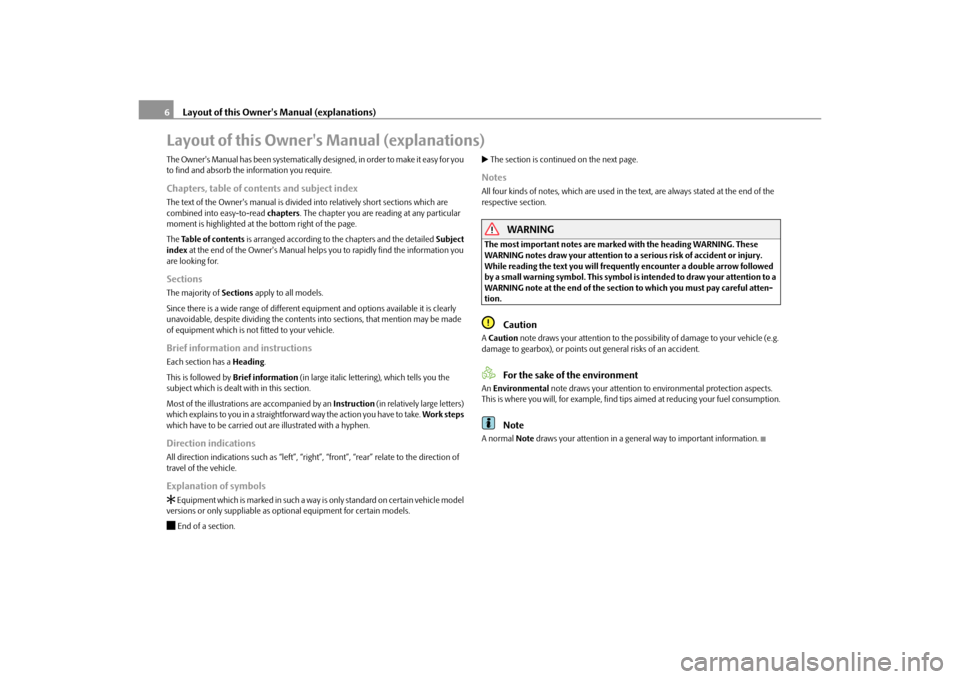
Layout of this Owner's Manual (explanations)
6
Layout of this Owner's Manual (explanations)The Owner's Manual has been systematically designed, in order to make it easy for you
to find and absorb the information you require.Chapters, table of contents and subject indexThe text of the Owner's manual is divided into relatively short sections which are
combined into easy-to-read chapters. The chapter you are reading at any particular
moment is highlighted at the bottom right of the page.
The Table of contents is arranged according to the chapters and the detailed Subject
index at the end of the Owner's Manual helps you to rapidly find the information you
are looking for.SectionsThe majority of Sections apply to all models.
Since there is a wide range of different equipment and options available it is clearly
unavoidable, despite dividing the contents into sections, that mention may be made
of equipment whic h is not fitted to your vehicle.Brief information and instructionsEach section has a Heading.
This is followed by Brief information (in large italic lettering), which tells you the
subject which is dealt with in this section.
Most of the illustrations are accompanied by an Instruction (in relatively large letters)
which explains to you in a straightforw ard way the action you have to take. Work steps
which have to be carried out are illustrated with a hyphen.Direction indicationsAll direction indications such as “left”, “right”, “front”, “rear” relate to the direction of
travel of the vehicle.Explanation of symbols Equipment which is marked in such a way is only standard on certain vehicle model
versions or only suppliable as opti onal equipment for certain models. End of a section.
The section is continued on the next page.NotesAll four kinds of notes, which are used in th e text, are always stated at the end of the
respective section.
WARNING
The most important notes are marked with the heading WARNING. These
WARNING notes draw your attention to a serious risk of accident or injury.
While reading the text you will frequent ly encounter a double arrow followed
by a small warning symbol. This symbol is intended to draw your attention to a
WARNING note at the end of the section to which you must pay careful atten-
tion.
Caution
A Caution note draws your attention to the possib ility of damage to your vehicle (e.g.
damage to gearbox), or points ou t general risks of an accident.
For the sake of the environment
An Environmental note draws your attention to environmental protection aspects.
This is where you will, for example, find tips aimed at reducing your fuel consumption.
Note
A normal Note draws your attention in a general way to important information.
s2ug.6.book Page 6 Friday, April 9, 2010 2:24 PM
Page 21 of 271
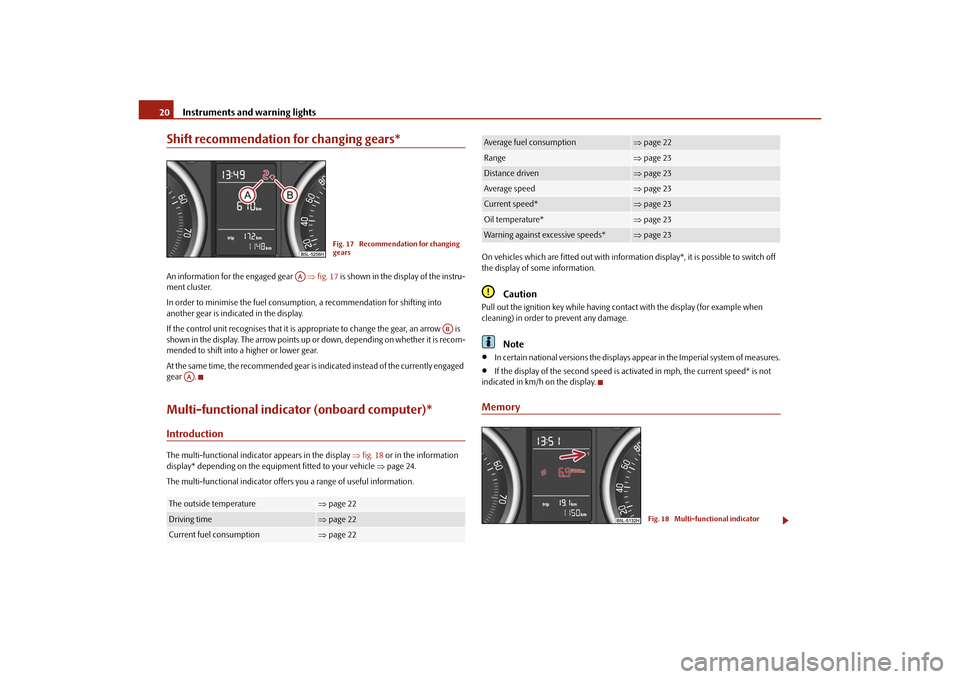
Instruments and warning lights
20
Shift recommendation for changing gears*An information for the engaged gear fig. 17 is shown in the display of the instru-
ment cluster.
In order to minimise the fuel consumptio n, a recommendation for shifting into
another gear is indicated in the display.
If the control unit recognises that it is a ppropriate to change the gear, an arrow is
shown in the display. The arrow points up or down, depending on whether it is recom-
mended to shift into a higher or lower gear.
At the same time, the recommended gear is indicated instead of the currently engaged
gear .Multi-functional indicator (onboard computer) *IntroductionThe multi-functional indicator appears in the display fig. 18 or in the information
display* depending on the equi pment fitted to your vehicle page 24.
The multi-functional indicator offers you a range of useful information. On vehicles which are fitted ou
t with information display*, it is possible to switch off
the display of some information.
Caution
Pull out the ignition key while having co ntact with the display (for example when
cleaning) in order to prevent any damage.
Note
In certain national versions the displays appear in the Imperial system of measures.
If the display of the second speed is acti vated in mph, the current speed* is not
indicated in km/h on the display.
Memory
The outside temperature
page 22
Driving time
page 22
Current fuel consumption
page 22
Fig. 17 Recommendation for changing
gears
AA
AB
AA
Average fuel consumption
page 22
Range
page 23
Distance driven
page 23
Average speed
page 23
Current speed*
page 23
Oil temperature*
page 23
Warning against excessive speeds*
page 23
Fig. 18 Multi-functional indicator
s2ug.6.book Page 20 Friday, April 9, 2010 2:24 PM
Page 23 of 271
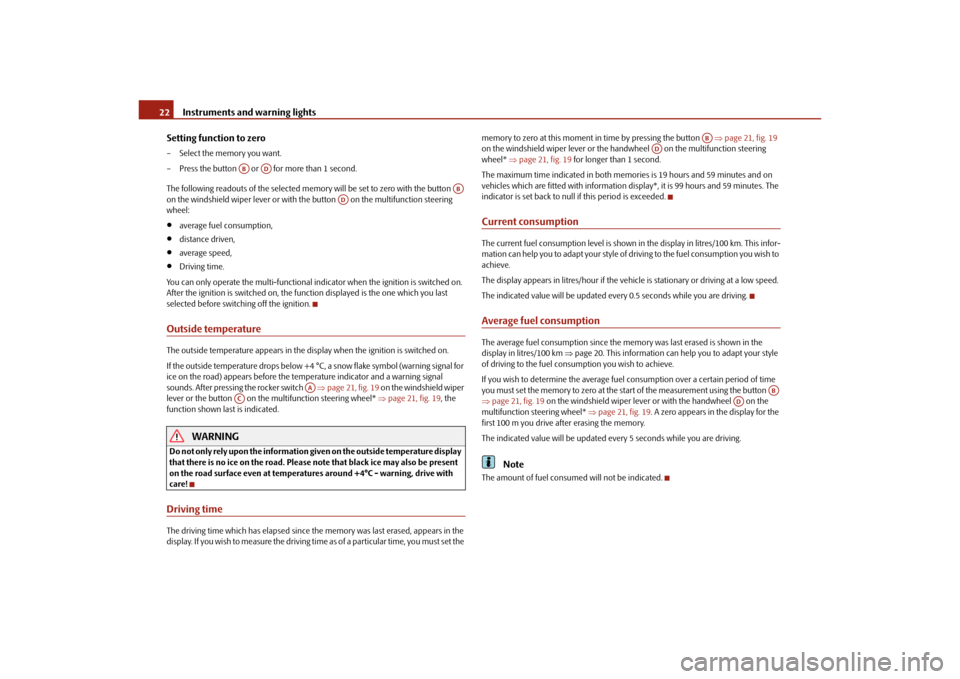
Instruments and warning lights
22
Setting function to zero
– Select the memory you want.
– Press the button or for more than 1 second.
The following readouts of the selected memory will be set to zero with the button
on the windshield wiper lever or with th e button on the multifunction steering
wheel:
average fuel consumption,
distance driven,
average speed,
Driving time.
You can only operate the multi-functional in dicator when the ignition is switched on.
After the ignition is switched on, the function displayed is the one which you last
selected before switching off the ignition.
Outside temperatureThe outside temperature appears in the disp lay when the ignition is switched on.
If the outside temperature drops below +4 °C, a snow flake symbol (warning signal for
ice on the road) appears before the temperature indicator and a warning signal
sounds. After pressing the rocker switch page 21, fig. 19 on the windshield wiper
lever or the button on the multifunction steering wheel* page 21, fig. 19, the
function shown last is indicated.
WARNING
Do not only rely upon the information given on the outside temperature display
that there is no ice on the road. Please note that black ice may also be present
on the road surface even at temperatures around +4°C - warning, drive with
care!Driving timeThe driving time which has elapsed since the memory was last erased, appears in the
display. If you wish to measure the driving time as of a particular time, you must set the memory to zero at this moment in time by pressing the button
page 21, fig. 19
on the windshield wiper lever or the handwheel on the multifunction steering
wheel* page 21, fig. 19 for longer than 1 second.
The maximum time indicated in both memories is 19 hours and 59 minutes and on
vehicles which are fitted with information display*, it is 99 hours and 59 minutes. The
indicator is set back to null if this period is exceeded.
Current consumptionThe current fuel consumption level is shown in the display in litres/100 km. This infor-
mation can help you to adapt your style of driving to the fuel consumption you wish to
achieve.
The display appears in litres/hour if the vehicle is stationary or driving at a low speed.
The indicated value will be updated every 0.5 seconds while you are driving.Average fuel consumptionThe average fuel consumption since the memory was last erased is shown in the
display in litres/100 km page 20. This information can help you to adapt your style
of driving to the fuel cons umption you wish to achieve.
If you wish to determine the average fuel consumption over a certain period of time
you must set the memory to zero at the start of the measurement using the button
page 21, fig. 19 on the windshield wiper lever or with the handwheel on the
multifunction st eering wheel* page 21, fig. 19 . A zero appears in the display for the
first 100 m you drive after erasing the memory.
The indicated value will be updated every 5 seconds while you are driving.
Note
The amount of fuel consumed will not be indicated.
AB
AD
AB
AD
AA
AC
AB
AD
AB
AD
s2ug.6.book Page 22 Friday, April 9, 2010 2:24 PM
Page 24 of 271
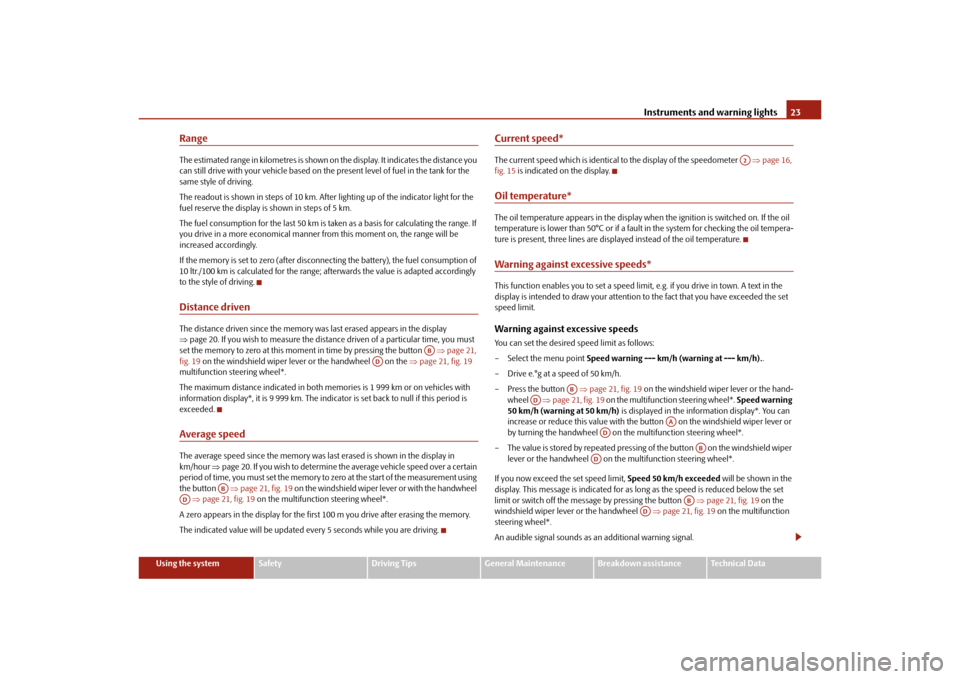
Instruments and warning lights23
Using the system
Safety
Driving Tips
General Maintenance
Breakdown assistance
Technical Data
RangeThe estimated range in kilometres is shown on the display. It indicates the distance you
can still drive with your vehicle based on th e present level of fuel in the tank for the
same style of driving.
The readout is shown in steps of 10 km. After lighting up of the indicator light for the
fuel reserve the display is shown in steps of 5 km.
The fuel consumption for the last 50 km is taken as a basis for calculating the range. If
you drive in a more economical manner fr om this moment on, the range will be
increased accordingly.
If the memory is set to zero (after disconnecting the battery), th e fuel consumption of
10 ltr./100 km is calculated for the range; afterwards the value is adapted accordingly
to the style of driving.Distance drivenThe distance driven since the memory was last erased appears in the display
page 20. If you wish to measure the distance driven of a particular time, you must
set the memory to zero at this moment in time by pressing the button page 21,
fig. 19 on the windshield wiper leve r or the handwheel on the page 21, fig. 19
multifunction steering wheel*.
The maximum distance indicated in both memo ries is 1 999 km or on vehicles with
information display*, it is 9 999 km. The indicator is set back to null if this period is
exceeded.Average speedThe average speed since the memory was last erased is shown in the display in
km/hour page 20. If you wish to determine the average vehicle speed over a certain
period of time, you must set the memory to zero at the start of the measurement using
the button page 21, fig. 19 on the windshield wiper lever or with the handwheel
page 21, fig. 19 on the multifunction steering wheel*.
A zero appears in the display for the first 100 m you drive after erasing the memory.
The indicated value will be updated every 5 seconds while you are driving.
Current speed*The current speed which is identical to the display of the speedometer page 16,
fig. 15 is indicated on the display.Oil temperature*The oil temperature appears in the display when the ignition is switched on. If the oil
temperature is lower than 50°C or if a fault in the system for checking the oil tempera-
ture is present, three lines are displayed instead of the oil temperature.Warning against excessive speeds*This function enables you to set a speed limit, e.g. if you drive in town. A text in the
display is intended to draw your attention to the fact that you have exceeded the set
speed limit.Warning against excessive speedsYou can set the desired speed limit as follows:
– Select the menu point Speed warning --- km/h (warning at --- km/h). .
– Drive e.°g at a speed of 50 km/h.
– Press the button page 21, fig. 19 on the windshield wiper lever or the hand-
wheel page 21, fig. 19 on the multifunction steering wheel*. Speed warning
50 km/h (warning at 50 km/h) is displayed in the information display*. You can
increase or reduce this value with the button on the windshield wiper lever or
by turning the handwheel on the multifunction steering wheel*.
– The value is stored by repeated pressing of the button on the windshield wiper lever or the handwheel on the multifunction steering wheel*.
If you now exceed the set speed limit, Speed 50 km/h exceeded will be shown in the
display. This message is indicated for as long as the speed is reduced below the set
limit or switch off the message by pressing the button page 21, fig. 19 on the
windshield wiper lever or the handwheel page 21, fig. 19 on the multifunction
steering wheel*.
An audible signal sounds as an additional warning signal.
AB
AD
AB
AD
A2
AB
AD
AA
AD
AB
AD
AB
AD
s2ug.6.book Page 23 Friday, April 9, 2010 2:24 PM
Page 63 of 271
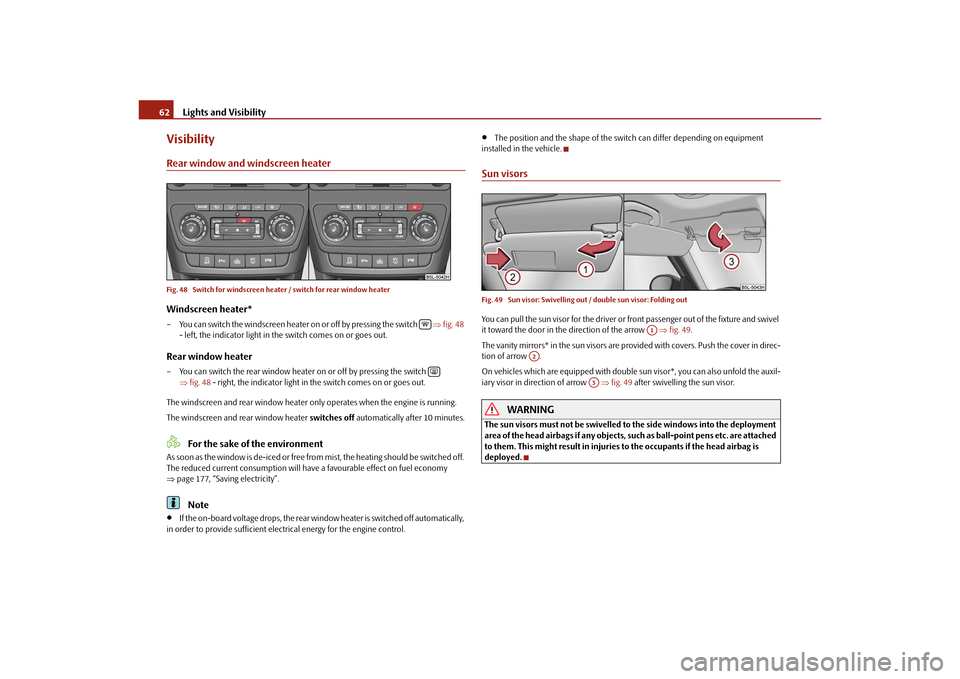
Lights and Visibility
62
VisibilityRear window and windscreen heaterFig. 48 Switch for windscreen heater / switch for rear window heaterWindscreen heater*– You can switch the windscreen heater on or off by pressing the switch fig. 48
- left, the indicator light in the switch comes on or goes out.Rear window heater– You can switch the rear window heater on or off by pressing the switch
fig. 48 - right, the indicator light in the switch comes on or goes out.
The windscreen and rear window heater on ly operates when the engine is running.
The windscreen and rear window heater switches off automatically after 10 minutes.
For the sake of the environment
As soon as the window is de-iced or free from mist, the heating should be switched off.
The reduced current consumption will have a favourable effect on fuel economy
page 177, “Saving electricity”.
Note
If the on-board voltage drops, the rear window heater is switched off automatically,
in order to provide sufficient electrical energy for the engine control.
The position and the shape of the switch can differ depending on equipment
installed in the vehicle.
Sun visorsFig. 49 Sun visor: Swivelling out / double sun visor: Folding outYou can pull the sun visor for the driver or front passenger out of the fixture and swivel
it toward the door in the direction of the arrow fig. 49 .
The vanity mirrors* in the sun visors are provided with covers. Push the cover in direc-
tion of arrow .
On vehicles which are equipped with double sun visor*, you can also unfold the auxil-
iary visor in direction of arrow fig. 49 after swivelling the sun visor.
WARNING
The sun visors must not be swivelled to the side windows into the deployment
area of the head airbags if any objects, su ch as ball-point pens etc. are attached
to them. This might result in injuries to the occupants if the head airbag is
deployed.
A1
A2
A3
s2ug.6.book Page 62 Friday, April 9, 2010 2:24 PM
Page 85 of 271
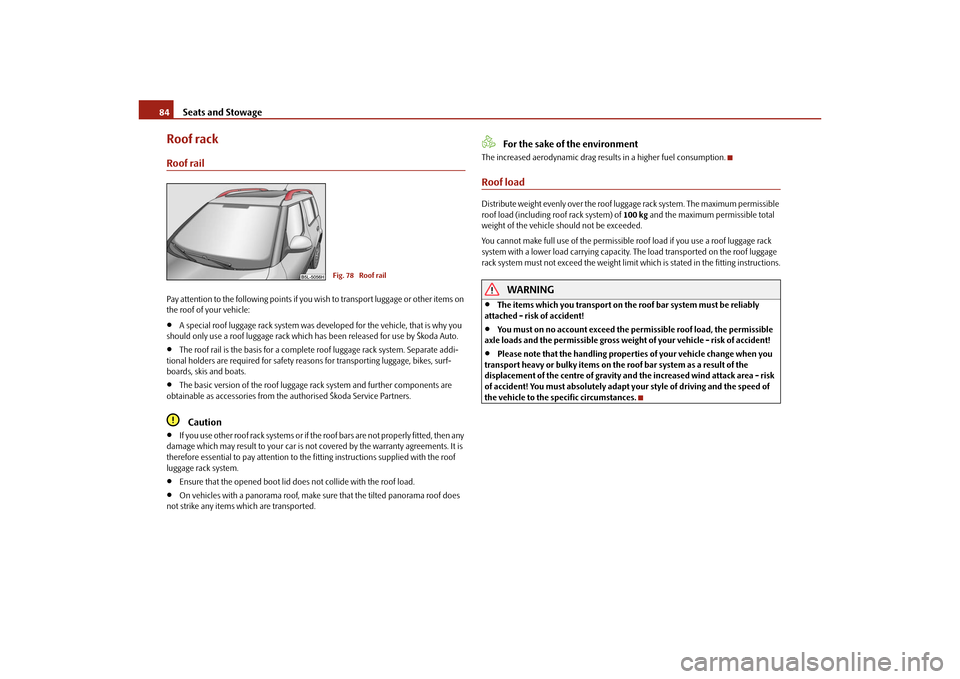
Seats and Stowage
84
Roof rackRoof railPay attention to the following points if you wish to transport luggage or other items on
the roof of your vehicle:
A special roof luggage rack system was de veloped for the vehicle, that is why you
should only use a roof luggage rack which has been released for use by Škoda Auto.
The roof rail is the basis for a complete roof luggage rack system. Separate addi-
tional holders are required for safety reasons for transporting luggage, bikes, surf-
boards, skis and boats.
The basic version of the roof luggage ra ck system and further components are
obtainable as accessories from the authorised Škoda Service Partners.Caution
If you use other roof rack systems or if the roof bars are not properly fitted, then any
damage which may result to your car is no t covered by the warranty agreements. It is
therefore essential to pay attention to the fitting instructions supplied with the roof
luggage rack system.
Ensure that the opened boot lid does not collide with the roof load.
On vehicles with a panorama roof, make su re that the tilted panorama roof does
not strike any items which are transported.
For the sake of the environment
The increased aerodynamic drag resu lts in a higher fuel consumption.Roof loadDistribute weight evenly over the roof lu ggage rack system. The maximum permissible
roof load (including roof rack system) of 100 kg and the maximum permissible total
weight of the vehicle should not be exceeded.
You cannot make full use of th e permissible roof load if you use a roof luggage rack
system with a lower load carr ying capacity. The load transported on the roof luggage
rack system must not exceed the weight limit which is stated in the fitting instructions.
WARNING
The items which you transport on the roof bar system must be reliably
attached - risk of accident!
You must on no account exceed the pe rmissible roof load, the permissible
axle loads and the permissible gross weight of your vehicle - risk of accident!
Please note that the handling proper ties of your vehicle change when you
transport heavy or bulky items on the roof bar system as a result of the
displacement of the centre of gravity an d the increased wind attack area - risk
of accident! You must absolutely adapt your style of driving and the speed of
the vehicle to the specific circumstances.
Fig. 78 Roof rail
s2ug.6.book Page 84 Friday, April 9, 2010 2:24 PM
Page 96 of 271
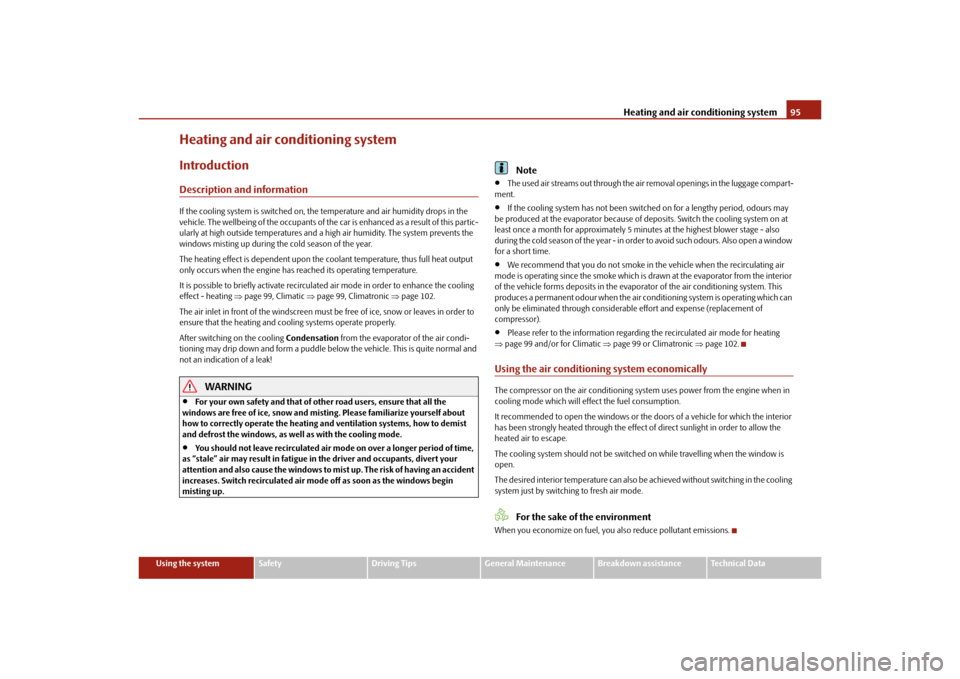
Heating and air conditioning system95
Using the system
Safety
Driving Tips
General Maintenance
Breakdown assistance
Technical Data
Heating and air conditioning systemIntroductionDescription and informationIf the cooling system is switched on, the temperature and air humidity drops in the
vehicle. The wellbeing of the occupants of the car is enhanced as a result of this partic-
ularly at high outside temperatures and a high air humidity. The system prevents the
windows misting up during th e cold season of the year.
The heating effect is dependent upon the c oolant temperature, thus full heat output
only occurs when the engine has reached its operating temperature.
It is possible to briefly activate recirculat ed air mode in order to enhance the cooling
effect - heating page 99, Climatic page 99, Climatronic page 102.
The air inlet in front of the windscreen must be free of ice, snow or leaves in order to
ensure that the heating and cooling systems operate properly.
After switching on the cooling Condensation from the evaporator of the air condi-
tioning may drip down and form a puddle be low the vehicle. This is quite normal and
not an indication of a leak!
WARNING
For your own safety and that of other road users, ensure that all the
windows are free of ice, snow and mistin g. Please familiarize yourself about
how to correctly operate th e heating and ventilation systems, how to demist
and defrost the windows, as well as with the cooling mode.
You should not leave recirculated air mode on over a longer period of time,
as “stale” air may result in fatigue in the driver and occupants, divert your
attention and also cause the windows to mist up. The risk of having an accident
increases. Switch recirculated air mode off as soon as the windows begin
misting up.
Note
The used air streams out through the air removal openings in the luggage compart-
ment.
If the cooling system has not been switched on for a lengthy period, odours may
be produced at the evaporator because of deposits. Switch the cooling system on at
least once a month for approximately 5 minu tes at the highest blower stage - also
during the cold season of the year - in order to avoid such odours. Also open a window
for a short time.
We recommend that you do not smoke in the vehicle when the recirculating air
mode is operating since the smoke which is drawn at the evaporator from the interior
of the vehicle forms deposits in the evapor ator of the air conditioning system. This
produces a permanent odour when the air conditioning system is operating which can
only be eliminated through considerable effort and expense (replacement of
compressor).
Please refer to the information regarding the recirculated air mode for heating
page 99 and/or for Climatic page 99 or Climatronic page 102.
Using the air conditioning system economicallyThe compressor on the air conditioning syst em uses power from the engine when in
cooling mode which will effect the fuel consumption.
It recommended to open the windows or the doors of a vehicle for which the interior
has been strongly heated through the effect of direct sunlight in order to allow the
heated air to escape.
The cooling system should not be switched on while travelling when the window is
open.
The desired interior temperature can also be achieved without switching in the cooling
system just by switching to fresh air mode.
For the sake of the environment
When you economize on fuel, you also reduce pollutant emissions.
s2ug.6.book Page 95 Friday, April 9, 2010 2:24 PM
Page 175 of 271
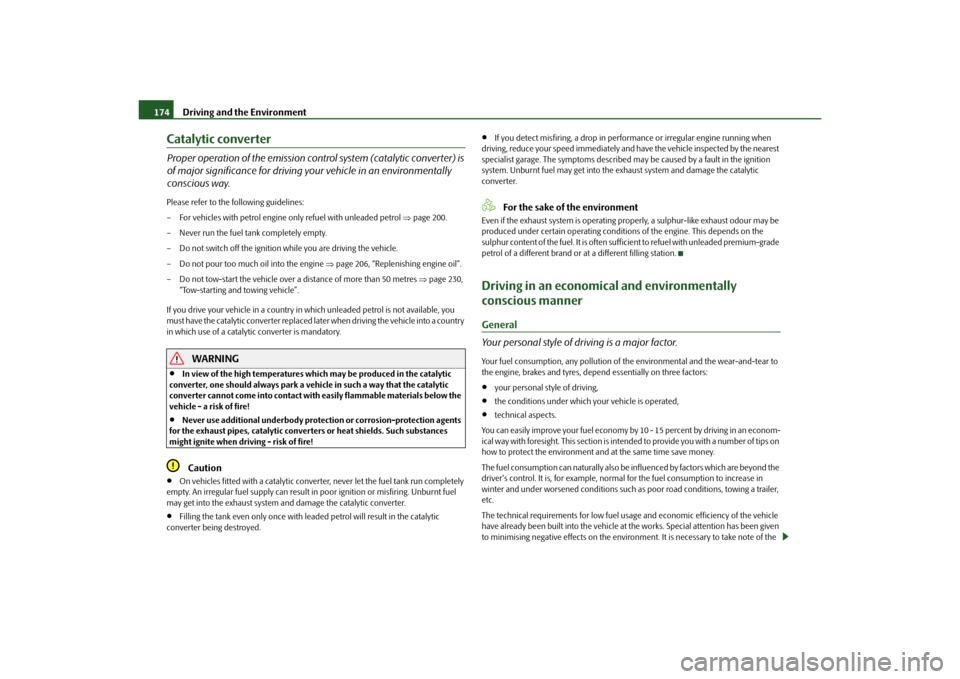
Driving and the Environment
174
Catalytic converterProper operation of the emission cont rol system (catalytic converter) is
of major significance for driving your vehicle in an environmentally
conscious way.Please refer to the following guidelines:
– For vehicles with petrol engine only refuel with unleaded petrol page 200.
– Never run the fuel tank completely empty.
– Do not switch off the ignition while you are driving the vehicle.
– Do not pour too much oil into the engine page 206, “Replenishing engine oil”.
– Do not tow-start the vehicle over a distance of more than 50 metres page 230,
“Tow-starting and towing vehicle”.
If you drive your vehicle in a country in which unleaded petrol is not available, you
must have the catalytic converter replaced la ter when driving the vehicle into a country
in which use of a catalyti c converter is mandatory.
WARNING
In view of the high temperatures which may be produced in the catalytic
converter, one should always park a vehicle in such a way that the catalytic
converter cannot come into contact with easily flammable materials below the
vehicle - a risk of fire!
Never use additional underbody protection or corrosion-protection agents
for the exhaust pipes, catalytic converters or heat shields. Such substances
might ignite when driving - risk of fire!Caution
On vehicles fitted with a catalytic converte r, never let the fuel tank run completely
empty. An irregular fuel supply can result in poor ignition or misfiring. Unburnt fuel
may get into the exhaust system and damage the cata lytic converter.
Filling the tank even only once with leaded petrol will result in the catalytic
converter being destroyed.
If you detect misfir ing, a drop in performance or irregular engine running when
driving, reduce your speed immediately and have the vehicle inspected by the nearest
specialist garage. The symptoms described ma y be caused by a fault in the ignition
system. Unburnt fuel may get into the exhaust system and damage the catalytic
converter.For the sake of the environment
Even if the exhaust system is operating pr operly, a sulphur-like exhaust odour may be
produced under certain oper ating conditions of the engine. This depends on the
sulphur content of the fuel. It is often sufficient to refuel with unleaded premium-grade
petrol of a different brand or at a different filling station.Driving in an economical and environmentally
conscious mannerGeneral
Your personal style of driving is a major factor.Your fuel consumption, any pollution of the environmental and the wear-and-tear to
the engine, brakes and tyres, depend essentially on three factors:
your personal style of driving,
the conditions under which your vehicle is operated,
technical aspects.
You can easily improve your fuel economy by 10 - 15 percent by driving in an econom-
ical way with foresight. This section is intended to provide you with a number of tips on
how to protect the environment and at the same time save money.
The fuel consumption can naturally also be influenced by factors which are beyond the
driver's control. It is, for example, normal for the fuel consumption to increase in
winter and under worsened cond itions such as poor road conditions, towing a trailer,
etc.
The technical requirements for low fuel usage and economic efficiency of the vehicle
have already been built into the vehicle at the works. Special attention has been given
to minimising negative effects on the environment. It is necessary to take note of the
s2ug.6.book Page 174 Friday, April 9, 2010 2:24 PM
Page 176 of 271

Driving and the Environment175
Using the system
Safety
Driving Tips
General Maintenance
Breakdown assistance
Technical Data
guidelines given in this chapter in order to
make best use of these characteristics and
to maintain their effectiveness.
The optimal engine speed should be obtained when accelerating, in order to avoid a
high fuel consumption and resonance of the vehicle.
Looking ahead when driving
A vehicle's highest fuel consumption occurs it accelerates.Avoid accelerating and braking unnecessarily. If you drive with forsight you will not
need to brake so often and will also then not have to accelerate so much. Let your
vehicle coast to a stop, for example, if this is possible, when you see that the next set of
traffic lights is at red.Shifting gears and saving energy
Shifting up early saves on fuel.Manual gearbox– Drive no more than about one length of your vehicle in first gear.
– Shift up into the next higher gear at approx. 2 000 to 2 500 revs.Automatic gearbox– Depress the accelerator pedal slowly. Do not depress it beyond the kickdown
position, however. An effective way of achieving good fuel economy is to shift up
early. You will consume
more fuel if you drive at unnecessaril y high revolutions in any given gear.
The fig. 151 shows the ratio of fuel consumption to the speed of your vehicle in the
relevant gear. Fuel consumption in 1st gear is the highest. The consumption is the
lowest in the highest gear.
You will achieve good fuel economy by shif ting up early and shifting down late.
Note
Also use the information supplied by the multi-functional indicator* page 20.Avoiding full throttle
Driving more slowly means saving fuel.Sensitive use of the accelerator will not only significantly reduce fuel consumption but
also positively influence environmenta l pollution and wear of your vehicle.
You should avoid exploiting the top speed of your vehicle wherever possible. Fuel
consumption, pollutant emissions and vehicl e noises increase disproportionally at
high speeds.
The fig. 152 shows the ratio between the fuel consumption and the speed of your
vehicle. You will cut your fuel consumption by half if you only make use three-quar ters
of the possible top speed of your vehicle.
Fig. 151 Fuel consumption in litres/100
km. and speed in km/h.
Fig. 152 Fuel consumption in litres/100
km. and speed in km/h.
s2ug.6.book Page 175 Friday, April 9, 2010 2:24 PM